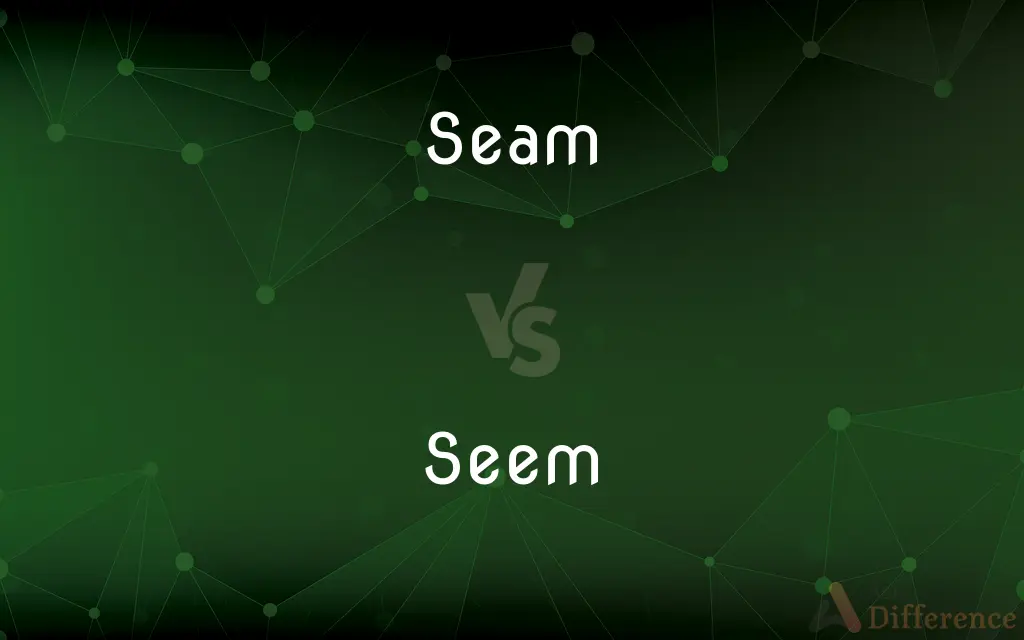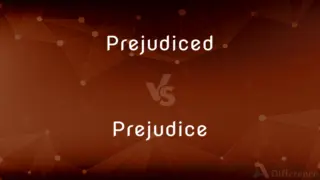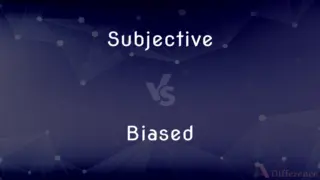Seam vs. Seem — What's the Difference?
By Maham Liaqat & Urooj Arif — Updated on April 24, 2024
Seam and seem differ primarily in meaning and use: "seam" refers to a line where two materials join, whereas "seem" suggests the appearance or impression of something.

Difference Between Seam and Seem
Table of Contents
ADVERTISEMENT
Key Differences
A seam typically is a physical joint resulting from sewing two pieces of fabric together, whereas seem is a verb that describes the appearance or impression something gives.
In construction, a seam can refer to a junction where two building materials meet, such as in sheet metal or woodworking, whereas seem might be used to describe how sturdy or well-made a structure appears.
In garment making, the quality of seams, which can be flat, overlapped, or decorative, significantly affects the final product's durability and aesthetics, whereas the use of seem in describing clothing often pertains to its perceived comfort or style.
Seams are crucial in the design and structural integrity of items ranging from clothes to furniture, focusing on the tangible aspects, whereas seem pertains to abstract perceptions, such as seeming reliable or luxurious.
The term seam also appears in geology, referring to a layer of mineral or rock, like a coal seam, emphasizing its tangible, material nature, while seem is used in expressions like "things are not what they seem," highlighting interpretive or suggestive nuances.
ADVERTISEMENT
Comparison Chart
Definition
A line where two pieces of material join together.
To appear or give an impression.
Part of Speech
Noun
Verb
Usage Context
Textiles, geology, construction.
General impression, appearance.
Examples in Sentences
"The seam of the dress was reinforced to prevent tearing."
"He seems happy about the new job."
Related Terms
Stitch, joint, weld.
Appear, look, sound.
Compare with Definitions
Seam
A joint consisting of stitches holding together pieces of fabric or other materials.
The tailor adjusted the seam of the jacket to provide a better fit.
Seem
To give an impression or appear in a certain way through indirect evidence.
It seems like it might rain today.
Seam
A geological layer of material, like coal, that forms a distinct layer.
Coal miners work to extract coal from seams deep underground.
Seem
To be perceived or interpreted in a specified manner.
He seems more confident this semester.
Seam
A line where two edges of material are joined in manufacturing.
The metal seams were welded to ensure they would hold under pressure.
Seem
To appear to be something, often based on impression.
She seems tired after the long trip.
Seam
The line formed by sewing together edges of fabric in garments.
The seams of her dress were intricately embroidered.
Seem
Used to describe the apparent state or condition of something.
The task seems difficult at first glance.
Seam
A boundary between adjacent layers of rock or earth.
The geologist pointed out the various mineral seams in the rock face.
Seem
To suggest or imply through appearance.
The evidence seems to point to a clear conclusion.
Seam
A line of junction formed by sewing together two pieces of material along their margins.
Seem
To give the impression of being in a certain way; appear to be
The child seems healthy, but the doctor is concerned. The house seems to be in good condition.
Seam
A similar line, ridge, or groove made by fitting, joining, or lapping together two sections along their edges.
Seem
Used to call attention to one's impression or understanding about something, especially in weakening the force of a following infinitive
I can't seem to get the story straight.
Seam
A suture.
Seem
To appear to be probable or evident
It seems you object to the plan. It seems like rain.
Seam
A scar.
Seem
(copulative) To appear; to look outwardly; to be perceived as.
He seems to be ill.
Her eyes seem blue.
It must have seemed to her she was safe.
How did she seem to you?
He seems not to be at home.
It seems like rain.
Seam
A line across a surface, as a crack, fissure, or wrinkle.
Seem
(obsolete) To befit; to beseem.
Seam
A thin layer or stratum, as of coal or rock.
Seem
To befit; to beseem.
Seam
To put together with or as if with a seam.
Seem
Give a certain impression or have a certain outward aspect;
She seems to be sleeping
This appears to be a very difficult problem
This project looks fishy
They appeared like people who had not eaten or slept for a long time
Seam
To mark with a groove, wrinkle, scar, or other seamlike line.
Seem
Seem to be true, probable, or apparent;
It seems that he is very gifted
It appears that the weather in California is very bad
Seam
To become fissured or furrowed; crack open.
Seem
Appear to exist;
There seems no reason to go ahead with the project now
Seam
(sewing) A folded-back and stitched piece of fabric; especially, the stitching that joins two or more pieces of fabric.
Seem
Appear to one's own mind or opinion;
I seem to be misunderstood by everyone
I can't seem to learn these Chinese characters
Seam
A suture.
Seam
(geology) A thin stratum, especially of an economically viable material such as coal or mineral.
Seam
(cricket) The stitched equatorial seam of a cricket ball; the sideways movement of a ball when it bounces on the seam.
Seam
A joint formed by mating two separate sections of materials.
Seams can be made or sealed in a variety of ways, including adhesive bonding, hot-air welding, solvent welding, using adhesive tapes, sealant, etc.
Seam
A line or depression left by a cut or wound; a scar; a cicatrix.
Seam
(figurative) A line of junction; a joint.
Seam
(historical) An old English measure of grain, containing eight bushels.
Seam
(historical) An old English measure of glass, containing twenty-four weys of five pounds, or 120 pounds.
Seam
Grease; tallow; lard.
Seam
To put together with a seam.
Seam
To make the appearance of a seam in, as in knitting a stocking; hence, to knit with a certain stitch, like that in such knitting.
Seam
To mark with a seam or line; to scar.
Seam
To crack open along a seam.
Seam
(cricket) Of the ball, to move sideways after bouncing on the seam.
Seam
(cricket) Of a bowler, to make the ball move thus.
Seam
Grease; tallow; lard.
Seam
The fold or line formed by sewing together two pieces of cloth or leather.
Seam
Hence, a line of junction; a joint; a suture, as on a ship, a floor, or other structure; the line of union, or joint, of two boards, planks, metal plates, etc.
Precepts should be so finely wrought together . . . that no coarse seam may discover where they join.
Seam
A thin layer or stratum; a narrow vein between two thicker strata; as, a seam of coal.
Seam
A line or depression left by a cut or wound; a scar; a cicatrix.
Seam
A denomination of weight or measure.
Seam
To form a seam upon or of; to join by sewing together; to unite.
Seam
To mark with something resembling a seam; to line; to scar.
Seamed o'er with wounds which his own saber gave.
Seam
To make the appearance of a seam in, as in knitting a stocking; hence, to knit with a certain stitch, like that in such knitting.
Seam
To become ridgy; to crack open.
Later their lips began to parch and seam.
Seam
Joint consisting of a line formed by joining two pieces
Seam
A slight depression in the smoothness of a surface;
His face has many lines
Ironing gets rid of most wrinkles
Seam
A stratum of ore or coal thick enough to be mined with profit;
He worked in the coal beds
Seam
Put together with a seam;
Seam a dress
Common Curiosities
How is the word 'seem' used in a sentence?
'Seem' is used to describe the appearance or impression that something gives, as in, "She seems happy."
What is a seam?
A seam is the line formed where two pieces of material are joined, typically by sewing.
What does it mean when something 'seems' a certain way?
It means that it appears or gives the impression of being that way, often based on perception rather than certainty.
Are there different types of seams in clothing?
Yes, there are various types of seams in clothing, such as plain, flat, French, and welt seams.
What does a 'flat seam' mean?
A flat seam refers to a type of sewing where the fabric layers are joined flush against each other, often used in athletic wear.
Can seams be decorative?
Yes, seams can be decorative, especially in fashion where they add to the design and aesthetic of garments.
Why is it important to distinguish between 'seam' and 'seem'?
Distinguishing between the two helps avoid confusion in communication, as one is a noun referring to a physical join and the other a verb related to perception.
Is 'seem' always subjective?
Generally, yes, 'seem' is used subjectively to express personal impressions or perceptions.
Can seams affect the comfort of clothing?
Yes, the placement and type of seams can significantly affect comfort, especially in areas of frequent movement.
Can the context change the meaning of 'seam' and 'seem'?
Yes, 'seam' can refer to different types of joins in various contexts like textiles or geology, while 'seem' can convey different levels of certainty about appearances.
What is the importance of seams in construction?
Seams are crucial in construction for ensuring the structural integrity and fit of materials like pipes, roofs, and walls.
What does 'seam' mean in geology?
In geology, a seam refers to a narrow layer of material, often minerals or coal, sandwiched between other layers.
How does 'seem' function in expressing uncertainty?
'Seem' is often used to express a tentative observation or opinion, indicating less than absolute certainty.
How do idiomatic expressions use 'seem'?
Idioms like "not everything is as it seems" use 'seem' to highlight differences between apparent and real situations.
How does the quality of seams impact the durability of products?
High-quality seams increase the durability and longevity of products by ensuring stronger joins and less likelihood of tearing or separation.
Share Your Discovery

Previous Comparison
Prejudiced vs. Prejudice
Next Comparison
Subjective vs. BiasedAuthor Spotlight
Written by
Maham LiaqatCo-written by
Urooj ArifUrooj is a skilled content writer at Ask Difference, known for her exceptional ability to simplify complex topics into engaging and informative content. With a passion for research and a flair for clear, concise writing, she consistently delivers articles that resonate with our diverse audience.














































